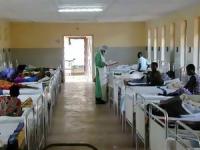-
Cocktail of bacteria-killing viruses prevents cholera infection in animal models
Oral administration of viruses that specifically target cholera bacteria prevents infection and cholera-like symptoms in animal model experiments. The findings are the first to demonstrate the potential efficacy of bacteria-killing viruses—known as bacteriophages, or phages—as an orally administered preventive therapy against an acute gastrointestinal bacterial disease.
-
-
Engineering mosquitoes to fight Zika
The United States Agency for International Development (USAID) has awarded a $1 million grant to Michigan State University to fight the Zika virus in Mexico. The funding will be used by Zhiyong Xi, MSU associate professor of microbiology and molecular genetics, to build a mosquito factory in Yucatan, Mexico. The facility will be modeled after a similar facility in Guangzhou, China which Xi leads in partnership with Sun Yat-sen University.
-
-
World still “grossly underprepared” for infectious disease outbreaks
The world remains “grossly underprepared” for outbreaks of infectious disease, which are likely to become more frequent in the coming decades, warn a team of international experts. They reviewed reports on the recent Ebola virus outbreak in West Africa and say better preparedness and a faster, more coordinated response could have prevented most of the 11,000 deaths directly attributed to Ebola and also the broader economic, social, and health crises that ensued. “We will not be ready for the next outbreak without deeper and more comprehensive change,” they conclude.
-
-
Odds are against a large Zika outbreak in the U.S.
Is the United States at risk for a large-scale outbreak of Zika or other mosquito-borne disease? While climate conditions in the United States are increasingly favorable to mosquitos, socioeconomic factors such as access to clean water and air conditioning make large-scale outbreaks unlikely, according to new analysis of existing research — but small-scale, localized outbreaks are an ongoing concern.
-
-
Final trial results confirm Ebola vaccine provides high protection against disease

Since Ebola virus was first identified in 1976, sporadic outbreaks have been reported in Africa. But the 2013-2016 West African Ebola outbreak, which resulted in more than 11,300 deaths, highlighted the need for a vaccine. An experimental Ebola vaccine was highly protective against the deadly virus in a major trial in Guinea, according to results published in The Lancet. The vaccine is the first to prevent infection from one of the most lethal known pathogens, and the findings add weight to early trial results published last year.
-
-
The new “100% effective” Ebola vaccine owes a debt to the scientists who beat smallpox

Almost a year after the official end of the Ebola outbreak in West Africa, the final results from one of the only Ebola vaccine trials are now in – and they look very promising. Despite being carried out under some of the most challenging conditions, the trial appears to be an exceptionally well-run study, comprehensive in its nature, and with a very positive result. This surely cements this vaccine as one important tool in controlling outbreaks of Ebola in the future. It also gives us a way to test new vaccines for other viruses that can crop up and take us by surprise, such as Lassa fever virus and Nipah viruses. We just have to hope that scientists have got more vaccines in the pipeline for us to test.
-
-
New math can help fight viral outbreaks
HIV … SARS … Ebola … H1N1 … Zika. The list of communicable global health threats seems ever growing, and frequently the limited resources available to fight these diseases must be picked up and redeployed — often haphazardly — as the next new threat emerges. But what if there were ways to wage a more effective war against all communicable diseases, using new combinations of proven complex sociological and statistical mathematic models to tell where an outbreak might occur, how it might spread and how best to fight it?
-
-
Real-time online epidemic tracking tool relies on open data, collective intelligence

Until now, disease data and geographic information about the movement of an infection or disease as it evolves and spreads has been locked up in databases that are often out of people’s reach. Researchers have been left to rely on published information in research papers, which may be many months out of date, containing static visuals which show only a small part of the whole disease or infection threat. Now, researchers have developed Microreact, a free, real-time epidemic visualization and tracking platform that has been used to monitor outbreaks of Ebola, Zika, and antibiotic-resistant microbes.
-
-
Predicting disease outbreak in a hyper-connected world
At the first hints of a disease outbreak, epidemiologists, health care providers, policy makers, and scientists turn to sophisticated predictive models to determine how an illness is spreading and what should be done to minimize contagion. New research is upending the traditional modeling process, yielding predictions that are both simpler to calculate and more attuned to a hyper-connected world.
-
-
Symptomless Ebola – questions need to be answered before the next outbreak
Scientists know that Ebola can cause anything from severe hemorrhagic fever to no symptoms at all (asymptomatic infections). What wasn’t known, until now, is the number of people who experienced asymptomatic infections during the 2013-2016 outbreak of Ebola in West Africa. While the new report of asymptomatic cases of Ebola virus infection is not unique, it does raise important questions that need to be answered. Over the last couple of years, governments and global public health agencies have increased resources to tackle these questions. Hopefully, we will be better equipped and prepared for the next outbreak.
-
-
Factors influencing the timing of infectious disease outbreaks
The delay between the time when a disease outbreak becomes possible and when it actually happens depends chiefly on how frequently infection is introduced to the population and how quickly the number of cases caused by a single individual increases, according to new research. The research lays the theoretical groundwork for a disease forecasting system that could give public health officials time to prepare for-or possibly even prevent-certain outbreaks in the future.
-
-
Exonerating “Patient Zero”: Debunking the myth of the origins of the 1980s U.S. AIDS crisis
The genetic testing of decades-old blood samples has demonstrated that Gaétan Dugas, a French-Canadian flight attendant who became notorious as the human epicenter of the U.S. AIDS crisis of the 1980s – and the first person to be labeled the “Patient Zero” of any epidemic – was simply one of many thousands infected in the years before HIV was recognized. In fact, the very term Patient Zero was the result of a misreading: In one of the early cluster studies of AIDS patients in California, Dugas was code-named “Patient O” (for “[O]utside-of-California”) – but some researchers discussing the investigation began interpreting the ambiguous oval as a digit, and referring to Patient O as Patient 0.
-
-
MSF closes final West Africa Ebola projects for survivors
The Ebola outbreak that swept across West Africa infected more than 28,700 people and killed more than 11,300 men, women, and children. Whole families were ripped apart and communities were devastated by the disease, which saw schools close, economies grind to a halt and health systems collapse, leading to even greater loss of life. The shocking human toll of the outbreak was exacerbated by the painfully slow international response. More than two and a half years after the Ebola outbreak officially began, MSF is now closing its last projects in West Africa dedicated to caring for people who survived the disease.
-
-
Combatting antibiotic resistance
CDC has awarded more than $14 million to fund new approaches to combat antibiotic resistance, including research on how microorganisms naturally present in the human body (referred to as a person’s microbiome) can be used to predict and prevent infections caused by drug-resistant organisms. The initiative, which also provides funding for state health departments and other partners, implements the tracking, prevention, and antibiotic stewardship activities outlined in the National Action Plan for Combating Antibiotic-Resistant Bacteria.
-
-
Business cycle drives the spread of viral diseases
Next time a flu epidemic hits your area, putting everyone in bed, rejoice: it may mean that the recession is over. A new paper highlights the connection between the business cycle and the spread of viruses: “We find that epidemics spread faster during economic booms,” the paper says. “During booms more people are traveling, which increases inter-personal contacts and the spread of diseases.”
-
- All
- Regional
- Water
- Biometrics
- Borders/Immig
- Business
- Cybersecurity
- Detection
- Disasters
- Government
- Infrastructure
- International
- Public health
- Public Safety
- Communication interoperabillity
- Emergency services
- Emergency medical services
- Fire
- First response
- IEDs
- Law Enforcement
- Law Enforcement Technology
- Military technology
- Nonlethal weapons
- Nuclear weapons
- Personal protection equipment
- Police
- Notification /alert systems
- Situational awareness
- Weapons systems
- Sci-Tech
- Sector Reports
- Surveillance
- Transportation
Advertising & Marketing: advertise@newswirepubs.com
Editorial: editor@newswirepubs.com
General: info@newswirepubs.com
2010-2011 © News Wire Publications, LLC News Wire Publications, LLC
220 Old Country Road | Suite 200 | Mineola | New York | 11501
Permissions and Policies
Editorial: editor@newswirepubs.com
General: info@newswirepubs.com
2010-2011 © News Wire Publications, LLC News Wire Publications, LLC
220 Old Country Road | Suite 200 | Mineola | New York | 11501
Permissions and Policies
